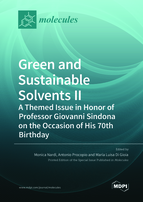Green and Sustainable Solvents II: A Themed Issue in Honor of Professor Giovanni Sindona on the Occasion of His 70th Birthday
A special issue of Molecules (ISSN 1420-3049). This special issue belongs to the section "Green Chemistry".
Deadline for manuscript submissions: closed (31 March 2020) | Viewed by 44953
Special Issue Editors
Interests: catalysis; green chemistry; organic synthesis; natural compounds; sustainable chemical processes
Special Issues, Collections and Topics in MDPI journals
Interests: catalysis; green chemistry; organic synthesis; natural compounds; sustainable chemical processes
Special Issues, Collections and Topics in MDPI journals
Interests: organic synthesis; peptide synthesis; green chemistry; natural compounds; sustainable chemical processes; green solvents; deep eutectic solvents
Special Issues, Collections and Topics in MDPI journals
Special Issue Information
Dear Colleagues,
Prof. Giovanni Sindona has been a full professor of Organic Chemistry at the University of Calabria (Unical) since 1990, and has made seminal contributions to the areas of food chemistry, mass spectrometry, and green chemistry. He graduated in chemistry in 1972 with the highest marks and price at the University of Messina, by discussing a thesis held at its Institute of Organic Chemistry on modern bioanalytical applications of mass spectrometry. He completed his training in 1977 at both the Universities of Messina and Calabria, followed by a stage at the Institut für Physikalische Chemie of the University of Bonn (Germany) as a fellow of the prestigious Alexander von Humboldt Foundation (of which he became a lifetime member), by perfecting the knowledge in mass spectrometry in the group of professor Hans D. Beckey. Here he developed knowledge in desorption methodologies which allowed for the first time the direct characterization of proteins and nucleic acids by mass spectrometry. His formation was completed as NATO fellow at the King’s College of London, where at the beginning of 1980, under the direction of Professor Colin B. Reese, he developed new synthetic organic methods for the obtainment of nucleic acids segments with a predetermined sequence. Professor Sindona also taught organic chemistry at the new Faculty of Pharmacy of the University Magna Graecia of Catanzaro, from 1990 to 1993.
From 1990 to 2019, Prof Sindona has organized and directed five NATO International Schools for young researchers on the application of mass spectrometry to biomolecular chemistry held in Italy and abroad. In 2009, as a member of the programme The Science for Peace and Security, he organized a NATO-ARW seminary in Calabria for experts coming from all over the world on the “Detection of Biological Agents and Toxins for the Prevention of Bioterrorism in Homeland Security by Advanced Mass Spectrometric Methods”. In April 2016, as local director he organized the NATO SPS ASI 984915 event in Calabria, titled “Molecular Technologies for Detection of Chemical and Biological Agents”, for young PhD students on environmental security problems.
Professor Sindona is a co-author of nearly four-hundred scientific publications on international papers in the English language (246) and ten book chapters edited by international societies on themes related to his scientific applications (10). He has been an invited speaker at many national and international meetings in the chemistry field, author of national and international conferences (149) and a teacher at doctorate schools at the American University of Vanderbilt (Nashville) and Purdue (West-Lafayette) and at the Memorial University of St. Johns in Canada. He is interested in the topics of food chemistry, mass spectrometry, and green synthesis and extraction methods.
In the green chemistry field, he has obtained interesting results in the efficient and stereoselective synthesis of trans-4,5-diaminocyclopent-2-enones from furfural using green solvents, published in 2013 in ACS Sustainable Chemistry and in 2017 in Green Chemistry.
Notably, interest has been raised in the use of homogeneous and heterogeneous catalysis in eco-friendly synthesis, which led to the publication of numerous and interesting papers on the major international scientific journals in the field of green chemistry and the development of new sustainable extraction methods of nutraceutical compounds from biomass.
This Special Issue, “Green and Sustainable Solvents II: A Themed Issue in Honor of Professor Giovanni Sindona on the Occasion of His 70th Birthday", aims to collect and publish recent advances in this interdisciplinary area. Research articles as well as reviews dealing with innovative techniques, alternative solvents, by-product valorization, and new routes for green solvents toward industrial applications are of interest. Manuscripts on how green solvents contribute to the development of natural products research are welcome. Molecules is very pleased to host this Special Issue, and invites scientists to submit their original contributions.
Dr. Monica Nardi
Prof. Antonio Procopio
Dr. Maria Luisa Di Gioia
Guest Editors
Manuscript Submission Information
Manuscripts should be submitted online at www.mdpi.com by registering and logging in to this website. Once you are registered, click here to go to the submission form. Manuscripts can be submitted until the deadline. All submissions that pass pre-check are peer-reviewed. Accepted papers will be published continuously in the journal (as soon as accepted) and will be listed together on the special issue website. Research articles, review articles as well as short communications are invited. For planned papers, a title and short abstract (about 100 words) can be sent to the Editorial Office for announcement on this website.
Submitted manuscripts should not have been published previously, nor be under consideration for publication elsewhere (except conference proceedings papers). All manuscripts are thoroughly refereed through a single-blind peer-review process. A guide for authors and other relevant information for submission of manuscripts is available on the Instructions for Authors page. Molecules is an international peer-reviewed open access semimonthly journal published by MDPI.
Please visit the Instructions for Authors page before submitting a manuscript. The Article Processing Charge (APC) for publication in this open access journal is 2700 CHF (Swiss Francs). Submitted papers should be well formatted and use good English. Authors may use MDPI's English editing service prior to publication or during author revisions.
Keywords
- Green Chemistry
- Organic synthesis
- Catalysis
- Green solvents
- Environmental impact
- Natural compounds









